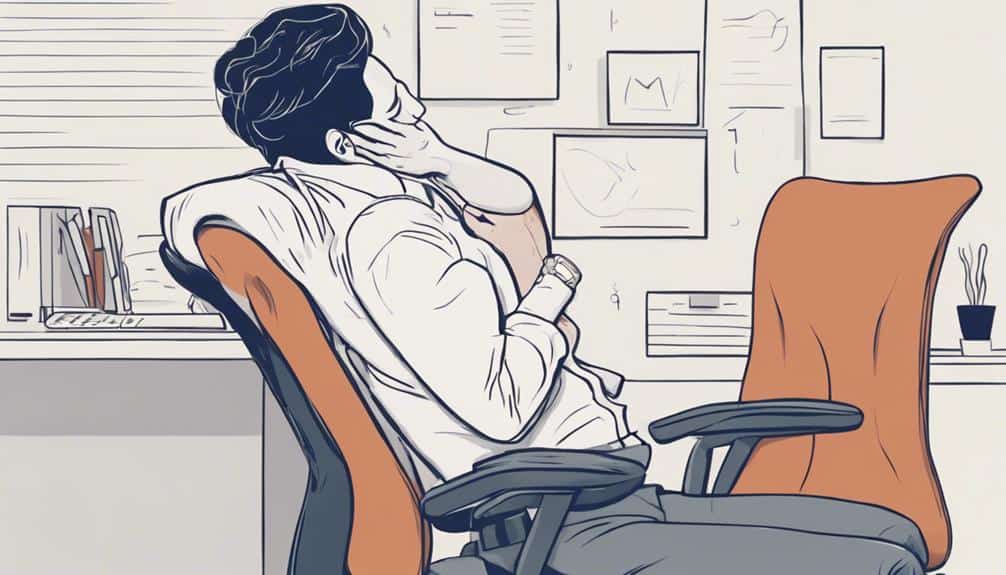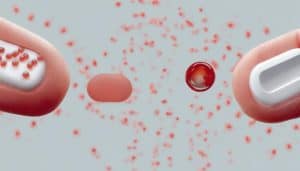When you're struck with a crick in your neck, characterized by sudden stiffness, pain, and limited mobility, you're not alone. Taking swift action can help alleviate discomfort and get you moving freely again. Rest, gentle exercises, and stress management techniques can provide relief. Simple stretches like neck tilts and shoulder rolls can reduce pain and stiffness. Applying ice or heat, taking over-the-counter medications, and practicing good posture can also help. By addressing the underlying causes and trying these remedies, you'll be well on your way to fixing that crick in your neck – and uncovering more ways to prevent future occurrences.
Key Takeaways
• Apply ice or heat to the affected area to reduce pain and inflammation, and consider over-the-counter pain relief medications.
• Practice gentle exercises like neck tilts, shoulder rolls, and upper trapezius stretches to improve flexibility and reduce muscle tension.
• Improve your posture while sitting, standing, and sleeping to avoid straining neck and upper back muscles, which can lead to neck cricks.
• Manage stress through relaxation techniques, like deep breathing, meditation, or yoga, to reduce muscle tension and prevent neck discomfort.
• Consider seeking professional help from a physical therapist or healthcare provider if neck pain persists or worsens over time.
Understanding Neck Cricks
When you experience a crick in your neck, you're likely to feel a sudden, unwelcome stiffness or pain that limits your range of motion and can be frustratingly debilitating. This discomfort can arise suddenly, making it difficult to move your neck or even perform daily tasks. A crick in the neck isn't an official medical diagnosis, but rather a broad term used to describe neck discomfort.
Common symptoms of a neck crick include stiffness, limited mobility, pain in the neck or shoulder, muscle knots, and a sensation like your neck needs to pop. You may find it painful to turn your head, bend, or even sit comfortably.
The good news is that there are ways to manage and treat neck cricks. While the causes of neck cricks vary, they often involve muscle strain, neck sprain, musculoskeletal conditions, or even mental health concerns like stress. Fortunately, you can take steps to alleviate the discomfort.
Home remedies like rest, gentle exercises, and stress management techniques can help. In some cases, professional help like physical therapy may be necessary. By understanding neck cricks, you can take the first step towards finding relief and avoiding future occurrences.
Causes of Neck Cricks

What triggers a crick in your neck, and how can you identify the underlying causes to prevent future occurrences? You might be surprised to learn that it's often a combination of factors that lead to that annoying kink in your neck.
One common culprit is muscle spasm, which can occur when your neck and upper back muscles are stressed. This stress can be exacerbated by poor head and neck posture, which puts additional strain on your muscles. Additionally, underlying conditions like cervical herniated discs can contribute to neck pain or radiculopathy, leading to a crick in your neck.
Cervical spinal stenosis, caused by bone spurs in the spinal canal, can also lead to neck stiffness and pain, making it more prone to cricks. It's worth noting that your neck has to support the weight of your head, which is roughly equivalent to a bowling ball, making it more susceptible to strain and cricks.
When you're under stress, your muscles tense up, making your neck more prone to cricks.
Home Remedies for Relief

To find relief from a crick in your neck, you can try applying ice or heat to reduce inflammation and relieve muscle spasms, and combine this with rest and over-the-counter pain medications to alleviate discomfort. This combination can help reduce pain and inflammation, making it easier to move your neck and return to your daily activities.
| Home Remedies | Benefits |
|---|---|
| Apply Ice or Heat | Reduce inflammation, relieve muscle spasms |
| Rest | Avoid prolonged bed rest, aid in recovery |
| Over-the-counter medications | Alleviate pain and discomfort |
In addition to these remedies, making lifestyle adjustments can help prevent future occurrences of neck cricks. Improving your sleeping position, for instance, can reduce the strain on your neck and prevent muscle strain. If your symptoms persist, you may need to seek professional help, which can include physical therapy, corticosteroid injections, or stronger pain medications. By incorporating these home remedies and lifestyle adjustments into your daily routine, you can effectively manage and prevent neck cricks.
Simple Stretches for Neck Pain

As you start to address the crick in your neck, you'll want to focus on exercises that target specific muscle groups.
You'll find that simple stretches can quickly relieve tension and improve mobility.
Neck Stretching Exercises
By incorporating simple yet effective neck stretching exercises into your daily routine, you can greatly reduce neck pain and stiffness. These exercises can help alleviate neck pain by improving flexibility and reducing muscle tension.
You can target different neck muscles with simple stretches like neck tilts, shoulder rolls, head tilts, and upper trapezius stretches. The best part? You can do these exercises at home or at work, making it easy to fit them into your busy schedule.
Consistency is key, so aim to practice these stretches regularly to improve circulation, promote relaxation, and enhance overall neck health. Remember to perform these stretches gently and without causing pain to avoid further aggravating the neck muscles.
Relieving Tension Quickly
When a crick in your neck strikes, simple stretches can provide quick relief from tension and discomfort. By incorporating these exercises into your daily routine, you can alleviate pain and stiffness, restoring comfort to your neck.
Here are some simple stretches to relieve tension quickly:
- Neck Tilts: Slowly tilt your head to the side, holding for 10-15 seconds and repeating 4 times on each side.
- Shoulder Rolls: Roll your shoulders forward and backward, holding for 10-15 seconds and repeating 4-5 times.
- Head Tilts: Tilt your head to the side, bringing your ear towards your shoulder, holding for 10-15 seconds on each side and repeating 4-5 times.
- Upper Trapezius Stretches: Gently tilt your head to the side, bringing your ear towards your shoulder, holding for 10-15 seconds on each side and repeating 4-5 times.
Over-the-Counter Pain Relief

When it comes to fixing a crick in your neck, over-the-counter pain relief options can be a lifesaver.
You'll find fast-acting medicines like acetaminophen and ibuprofen that can quickly reduce pain, inflammation, and discomfort.
Pain Relief Options
What options do you have for over-the-counter pain relief to alleviate the discomfort of a crick in your neck? Fortunately, you have several options to ponder. Over-the-counter pain relief can be a convenient and effective first step in managing a crick in your neck before contemplating other treatment options.
Here are some options to ponder:
- Acetaminophen (Tylenol): Helps reduce pain and discomfort associated with a crick in your neck.
- Ibuprofen (NSAIDs): Reduces pain, inflammation, and muscle spasms, making it an effective option for alleviating stiffness and discomfort in the neck.
- Follow recommended dosage instructions: Be sure to follow the recommended dosage instructions on the packaging to guarantee safe and effective use.
- Consult a healthcare provider: If you have any underlying health conditions or concerns, consult with a healthcare provider before taking any medication.
Remember to always follow the recommended dosage instructions and consult with a healthcare provider if you have any underlying health conditions or concerns.
Fast Acting Medicines
You can turn to fast-acting medicines like ibuprofen or acetaminophen to quickly alleviate neck pain and discomfort caused by a crick. These over-the-counter pain relief options can provide swift neck pain relief and reduce muscle soreness.
As nonsteroidal anti-inflammatory drugs (NSAIDs), ibuprofen and naproxen can reduce inflammation and discomfort in the neck, making them ideal for pain management. Acetaminophen, on the other hand, is effective for relieving pain and reducing fever.
When taking fast-acting medicines, it's essential to follow the recommended dosages and consult a healthcare provider if pain persists or worsens. Additionally, aspirin is another NSAID that can help with pain management for a crick in the neck.
Heat and Cold Therapy Options
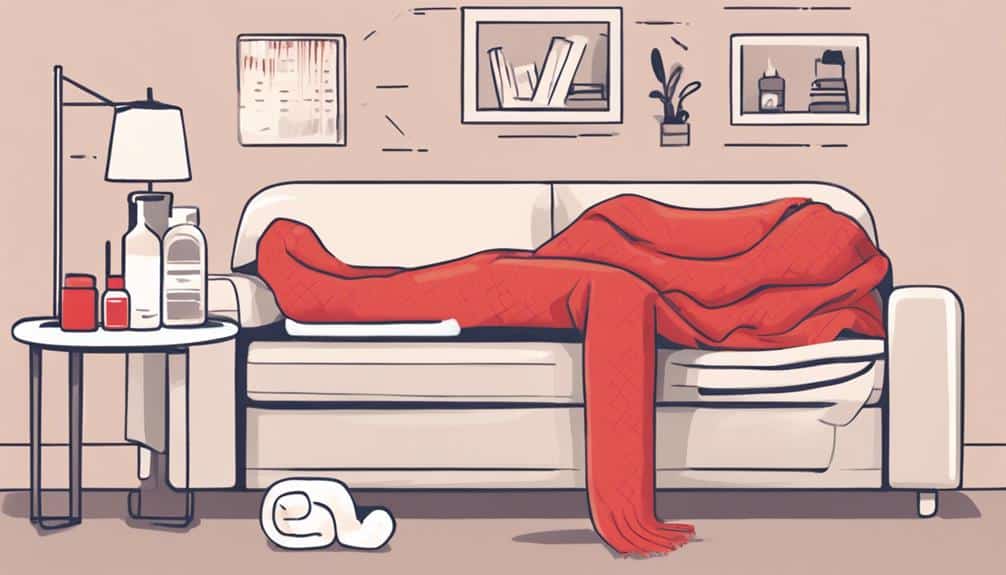
Applying heat and cold therapy can be an effective way to alleviate a crick in your neck, as each has unique benefits that can be leveraged to promote healing and relaxation.
Heat therapy helps increase blood flow, relax muscles, and relieve stiffness in the neck, making it an excellent option for soothing a crick. On the other hand, cold therapy can reduce inflammation, numb pain, and constrict blood vessels to alleviate discomfort. Alternating between heat and cold therapy can provide a balance of benefits for a crick in the neck.
Here are some key considerations when using heat and cold therapy:
- Duration of application: Heat packs or pads can be applied for 15-20 minutes at a time, while cold packs should be used for 10-15 minutes.
- Medical conditions: Consult a healthcare professional before using heat or cold therapy if you have certain medical conditions like diabetes or circulation problems.
- Alternating therapy: Alternate between heat and cold therapy to reap the benefits of both.
- Frequency of application: Apply heat or cold therapy as needed, but avoid overusing it to prevent discomfort or skin irritation.
Remember to always follow proper application guidelines and consult with a healthcare professional if you have any concerns. By incorporating heat and cold therapy into your self-care routine, you can effectively alleviate a crick in your neck and promote overall relaxation and healing.
Preventing Future Neck Cricks
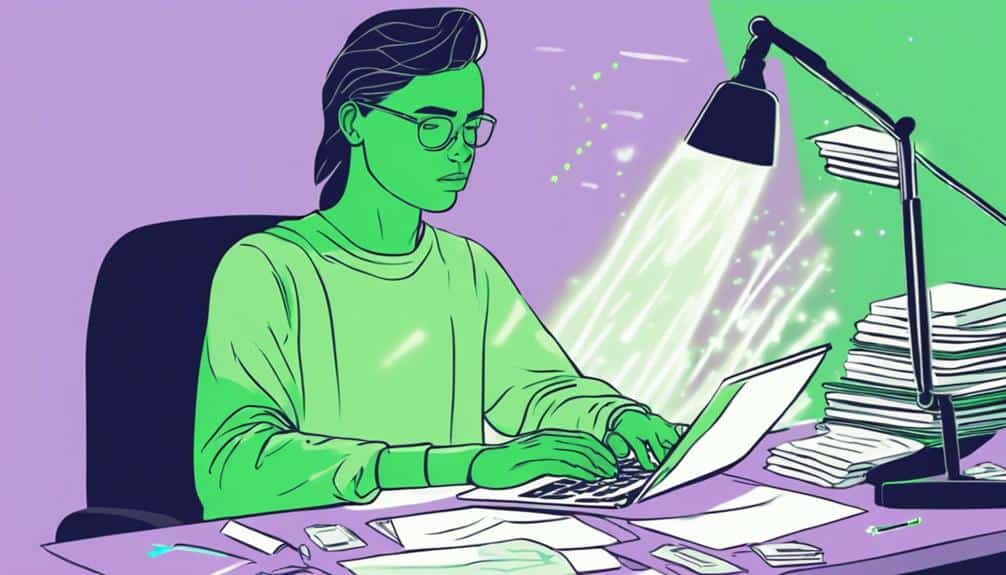
In order to prevent future neck cricks, cultivating habits that reduce strain on your neck muscles is essential, starting with maintaining good posture in all aspects of your daily life. This means sitting up straight, standing tall, and sleeping on a supportive pillow that keeps your spine aligned.
Regular neck stretches and strengthening exercises can also help improve flexibility and reduce muscle tension, making it less likely for a crick to develop.
When performing daily activities, avoid sudden movements or jerking motions that can strain your neck. Instead, move slowly and deliberately to reduce the risk of injury. Investing in ergonomic equipment, such as a comfortable chair and a well-designed computer setup, can also help reduce strain on your neck.
Additionally, maintaining a healthy weight and staying hydrated can reduce pressure on your neck and spine, making it less likely for a crick to develop.
When to Seek Medical Attention
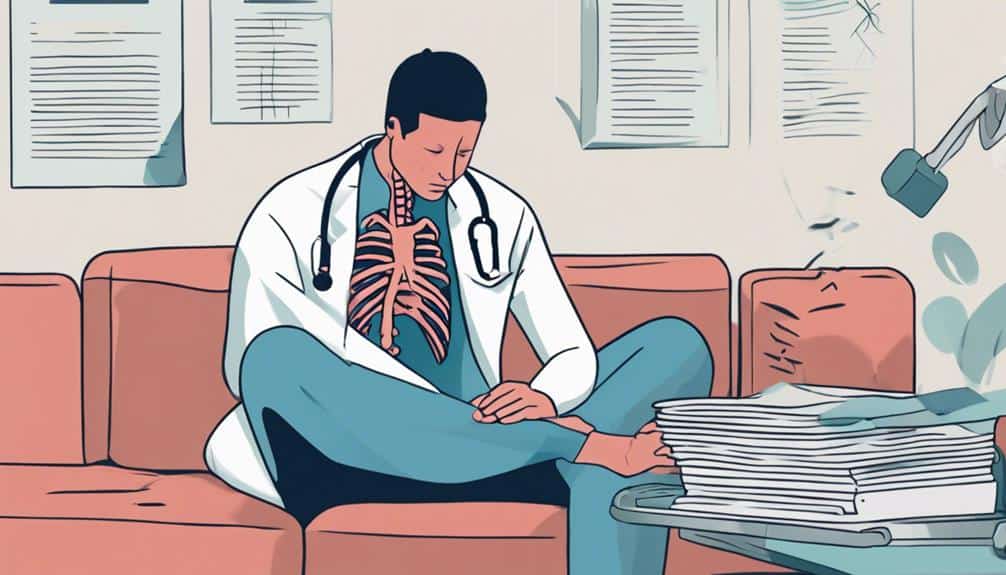
While maintaining good posture and incorporating preventative measures into your daily routine can go a long way in reducing the risk of future neck cricks, there may come a time when medical attention is necessary to address persistent or severe neck pain. If you're experiencing a stiff neck or chronic neck pain that persists despite home treatment, it's important to know when to seek medical attention.
Here are some alarming symptoms that warrant a visit to a healthcare provider:
- Persistent pain: If your neck pain persists for more than a few days or doesn't improve with rest and basic remedies after a week, it's time to seek medical attention.
- Numbness or weakness: If you're experiencing numbness, weakness, or difficulty with fine motor skills accompanying neck pain, don't hesitate to consult a doctor or spine specialist.
- Injury or trauma: After an injury such as a car accident or fall, it's crucial to consult a medical professional for evaluation and treatment of neck pain, as it may indicate a herniated disc, muscle strain, or pinched nerve affecting your cervical spine.
- Radiating pain or persistent headaches: If you're experiencing radiating pain or persistent headaches alongside neck pain, seek medical attention to rule out any underlying conditions that may require urgent treatment.
Can the Same Remedies for Healing a Burnt Tongue Help Fix a Crick in Your Neck?
Yes, some remedies to heal a burnt tongue injury can also help alleviate a crick in your neck. Applying aloe vera gel, using a cold compress, or taking over-the-counter pain relievers may provide relief for both types of discomfort. However, it’s always best to consult with a healthcare professional for proper treatment.
Can a Crick in the Neck Cause Tooth Looseness?
A crick in the neck may not directly cause tooth looseness, but the tension and discomfort can lead to teeth grinding, which can contribute to the problem. However, it’s important to consult a dentist for proper treatment and not attempt to tighten a loose tooth at home.
Frequently Asked Questions
How Do You Get Rid of a Cricked Neck Fast?
To get rid of a cricked neck fast, you'll want to act quickly. Apply ice or heat packs to reduce inflammation and relax tense muscles.
Next, gently stretch your neck, focusing on slow, controlled movements. Consider taking over-the-counter pain meds like ibuprofen or acetaminophen for temporary relief.
How Long Does a Neck Crick Last?
You're probably wondering how long a neck crick will last. Typically, it resolves on its own within a few hours to a few days with self-care. However, in some cases, it can persist for a week or longer, requiring medical attention. Factors like posture, daily activities, and stress levels can impact its duration.
Can You Massage a Crick Out of Your Neck?
You're likely one of the 70% of people who experience neck pain at some point, and you're wondering if massage can help.
The good news is yes, you can massage a crick out of your neck! By applying gentle, circular motions with your fingertips or a massage tool, you can relax tight muscles, improve blood flow, and reduce pain and stiffness.
Be cautious not to apply too much pressure, and you'll be on your way to a crick-free neck.
Should You Stretch a Crick in Your Neck?
You're wondering if you should stretch a crick in your neck. The answer is yes! Gentle stretching exercises can target tight neck muscles, promoting relaxation and reducing muscle spasms.
By incorporating stretching into your routine, you'll improve flexibility and reduce stiffness. Remember to use proper techniques to avoid further strain.
Consistency is key, so make stretching a regular habit to prevent future episodes of neck discomfort and maintain peak neck health.
Conclusion
You've made it this far, and your neck crick is finally starting to subside. But don't think you're out of the woods yet. The real challenge lies ahead – maintaining a crick-free neck.
Remember, one wrong move, one awkward sleep, or one stressful day can trigger a relapse. Stay vigilant, keep stretching, and keep those heat packs handy.
The battle against neck cricks is ongoing, and only you can guarantee your hard-won relief lasts.
